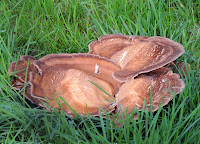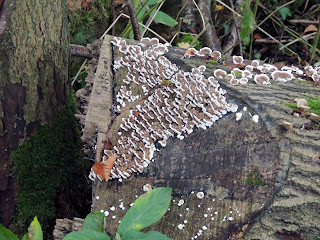SKYLARK SUE’S
REFLECTIONS OF NATURE
November
2013
Then the leaves go whirling past
 |
| Colour at Anglesey Abbey |
 |
| Mute swans at Hatfield Forest |
 |
| The lake at Hatfield Forest |
 |
| Last month's storm damage at Hatfield Forest |
A visit to Hatfield Forest on
the 3rd revealed many trees broken or fallen due to last month’s gale, and I
was surprised to see some striped snails that had worked their way up the trunk
of one upright tree. A lot of the trees are still green, especially those around
the lake; the autumn colours haven’t completely taken hold though the leaves
look tired and are beginning to discolour.
November 4th was a perfect
day to visit the RSPB reserve at Rye Meads, near Broxbourne, Hertfordshire. It
was a beautiful, sunny day with a cloudless blue sky. Even so, I was surprised
to see half-a dozen or so peacock butterflies in a group near one of the hides.
Although Rye Meads is one of the smaller of the RSPB reserves, there are
several trails and hides overlooking scrapes and lagoons. From the Tern Hide
I spotted teal, gadwall, shoveler, coots and moorhens, as well as around 150 or
so lapwings, which suddenly all arose in the air, a fantastic whirling
spectacle against the blue sky. From other hides I saw gulls, mainly
black-headed, and tufted ducks, mute swans and cormorants, and I watched a wren
through one of the slats. Bushes along the paths were heavy with scarlet hips
and haws, and there were even some roses still in bloom. There was a very
strange fungus on the ground in one place. It closely resembled lumps of white
polystyrene and was slightly slimy to touch.
Many of our garden birds have
been absent over the last couple of weeks, presumably because there are so many
insects, fruits and berries around. On the 8th there were a few sparrows and
tits around the feeder, and a magpie had been visiting the apple tree where a
few apples still remain. On the 10th we moved the bird feeder pole from the lawn
to its winter position on the garden path. It’s necessary to do this, as the
lawn tends to get very boggy in the winter months and it’s much easier to
replenish the feeders when they are so easily accessible, especially if we get
snow. Great tits soon found the feeders, and gradually the other birds followed
suit. A dunnock was spotted there on the 14th. At one time the dunnocks seemed
quite shy birds in the garden, timidly shuffling around under the bushes, but
now they are much bolder and will hold their own with larger birds on the feeder
trays.
The mild weather had
continued, and by the 15th there were still plenty of insects about, so apart
from the occasional sparrow, wood pigeon, tit or dunnock the feeders remained
deserted. The trees were really turning now, and the oak across the road was
mainly gold with just a few green leaves. It bore a good crop of acorns – oaks and
horse chestnuts seem to all be cropping well this year. In fact, it’s been a
bumper harvest for most trees and bushes, so if we do have a hard winter there
will be a good crop of food for hungry birds. On the 18th a robin was following
my husband around the garden, taking the worms and grubs as they were turned up
in the soil. From the car on the 20th I spotted a kestrel hovering low near
Bourne in Lincolnshire. It’s always so frustrating to get quick glimpses of
birds from the car – there is rarely time to observe them, let alone grab a
photo. This was yet another blue-skied day, feeling more like early autumn.
The weather was getting a bit
colder now and the birds were returning to the garden. On the 20th the sparrows
had claimed their patch in the pyracantha and were very active on the feeders.
The squirrel had been visiting frequently over the last few days, too. Surprisingly,
on the 24th there were still some alpine strawberries waiting to ripen but it must be
too late now. With the weather remaining chilly, as well as the sparrows in the
garden there were two blackbirds, two dunnocks, three blue tits, and a robin. Magpies were in the oak opposite as usual. The
following day the birds in the garden had been joined at the feeders by great tits, a wood pigeon
and several starlings.
 |
| Stream at Anglesey Abbey |
 |
| Stream at Anglesey Abbey |
A trip to the grounds of
Anglesey Abbey, Cambs, on the 25th proved a delight as, once more, the sun was
shining from a bright blue sky, showing off the trees to their best advantage.
The autumn tints were stunning and there were plenty of berries, including some purple Beauty Berry (Callicarpa dichotoma). The algae that
had been so thick earlier in the year on the stream had either been cleared or
had died away, and the water was clear. Sightings included great spotted
woodpecker, blackbirds, great tits, goldcrests, a large flock of goldfinches
and a particularly friendly robin who pecked around our feet along the woodland
path. Amazingly, we even saw a bee on one of the shrubs.
 |
| Great Tit in Hiding! |
On the 27th there was a small
mixed flock of blue tits and long-tailed tits in the hedgerow across the road
from our garden, and there were collared doves back in the garden on the 29th.
On the last day of the month the garden was visited by starlings, sparrows,
blue tits, great tits, dunnocks and blackbirds.
No morn - no noon -
No dawn - no dusk - no proper time of day.
No warmth, no cheerfulness, no healthful ease,
No comfortable feel in any member -
No shade, no shine, no butterflies, no bees,
No fruits, no flowers, no leaves, no birds! -
November!
















































